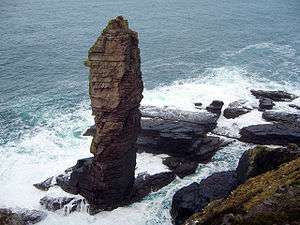Old Man of Stoer

The Old Man of Stoer is a 60 metres (200 ft) high sea stack of Torridonian sandstone in Sutherland, Scotland, close to villages of Culkein and Stoer and the nearby Stoer Head Lighthouse. It is a popular climbing route.
Geography
The stack is composed of Torridonian sandstone, and is 60 metres (200 ft) high.[1] It is located in The Minch, a strait in north-west Scotland, separating the north-west Highlands, and the northern Inner Hebrides, from Lewis and Harris in the Outer Hebrides.[2]
Access is normally from the Stoer Head Lighthouse, which is within walking distance of the stack.[1] The lighthouse is on the B869 Lochinver to Unapool road.[3]
The seas around the Old Man of Stoer have claimed a number of vessels. There is believed to be the wreck of a fishing boat in the vicinity of the stack, which sank on 17 February 1953.[4]
Climbing

The Old Man of Stoer is popular with climbers due to its height and approachability.[5] It was first climbed in 1966 by Brian Henderson, Paul Nunn, Tom Patey and Brian Robertson.[6] Along with Am Buachaille and the Old Man of Hoy, it has become something of a legend among climbers.[7]
To gain access to the foot of the stack, a Tyrolean traverse is necessary, which may require a swimmer to put it in place.[8] There are a number of routes of varying levels of difficulty.[8]
In the Channel 4 television programme Hidden Talent, 45-year-old Maggie Reenan climbed the stack after 18 days of intensive training, after her natural aptitude for climbing was discovered.[9][10]
Wildlife
Northern fulmars (Fulmarus glacialis) inhabit the stack and nearby sea cliffs.[1] Other wildlife in the area includes the great skua (also known by its Norse name "bonxie") peregrines, pinnipeds and cetaceans.[11]
Seabirds which can be seen include bonxies, twite, dunlin, guillemots, razorbills, skylarks, and fulmars.[12][13]
See also
References
- 1 2 3 Ross, David. "Old Man of Stoer". Britain Express. Retrieved 1 December 2013.
- ↑ "North West Highlands" (PDF). Island of Hoy Development Trust. Retrieved 1 December 2013.
- ↑ "The Old Man of Stoer and the Point of Stoer". Walking Britain. Retrieved 1 December 2013.
- ↑ "Grateful: Old Man of Stoer, North Minch". Royal Commission on the Ancient and Historical Monuments of Scotland. Retrieved 1 December 2013.
- ↑ Mellor, Chris. "Stack Rock" (PDF). UKClimbing Limited. Retrieved 1 December 2013.
- ↑ Robinson, Adrian Henry Wardle; Millward, Roy (1983). The Shell book of the British coast. p. 460. ISBN 9780715381502.
"The Old Man of Stoer and the point". walkhighlands.co.uk. Retrieved 1 December 2013.
Scott, Doug (1996). "Obituary: Paul James Nunn 1943-1995" (PDF). Alpine Journal. 101: 325–329. Retrieved 23 September 2014. - ↑ Grylls, Bear (2009). Bear Grylls Great Outdoor Adventures. p. 155. ISBN 9781905026524.
- 1 2 "Old Man of Stoer". UKClimbing Limited. Retrieved 1 December 2013.
- ↑ "Hidden Talent". Channel 4. 15 February 2012. Retrieved 1 December 2013.
- ↑ Heritage, Stuart (24 April 2012). "Hidden Talent: my quest to find one". The Guardian. Retrieved 1 December 2013.
- ↑ "Assynt Events 2011" (PDF). Assynt Leisure Centre. Retrieved 1 December 2013.
- ↑ "Seabirds at Stoer". Crafty Green Poet. 4 July 2012. Retrieved 1 December 2013.
- ↑ "Seabirds at Stoer". Pelagic Birder. 11 July 2013. Retrieved 1 December 2013.
Coordinates: 58°15′39.51″N 5°22′57.76″W / 58.2609750°N 5.3827111°W